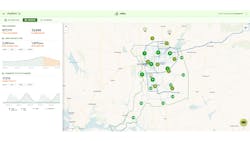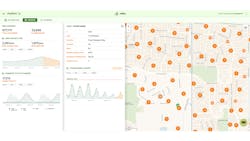Rhythmos app helps lessen EVs' drain on U.S. power grid
As the transition to electric vehicles accelerates, charging infrastructure will need to adapt. More than three million EVs are currently on the road in 2023, according to the U.S. Department of Energy, with that number growing to an anticipated 30-42 million EVs on the road by 2030, the National Renewable Energy Laboratory says.
Even with a little more conservative assumption of 28.3 million EVs on U.S. roads by 2030, S&P Global estimates a total of 2.13 million Level 2 and 172,000 Level 3 public chargers will be required in the next 7 or 8 years. That's in addition to the units that consumers put in their own garages.
Considering there are currently over 143,000 public and private EV chargers across the country, as seen here in the Alternative Fuels Data Center powered by the U.S Department of Energy, that's more than a 1,500% increase in charging infrastructure needed in less than a decade.
What does that mean for the U.S. power grid? Is the answer to add more charging stations or to create a smarter distribution network using the current infrastructure?
To find out, Fleet Maintenance spoke with Ken Munson, founder and CEO of Rhythmos, a company that developed an algorithm to optimize the entire electric mobility ecosystem. The Rhythmos app also considers EV fleet owner operational requirements, electric utility infrastructure capacity, grid constraints, and more.
Munson explained that the U.S. power grid is like a network where seven homes are supported by one transformer and each of those homes use about the same amount of electricity as one large EV truck, on average.
With the likelihood of entire fleets electrifying, and the power it takes to charge just one electric truck, one must consider how the grid will hold up in neighborhoods across North America, he said.
The main problem impacting utilities as EVs are introduced
Munson said the biggest concern is EVs' impact on the distribution network. He said typically when an EV is added to the grid, it's put on a time of use rate structure, which incentivizes someone to charge between a particular window of time outside of the peak load time, which is midday.
"But the problem is it just moves the problem, the peak load, from one point in time during the day to another point in time—it doesn't eliminate it," he said, adding most charging solutions are "designed to charge around time of use."
He suggested that when an asset is charging, the network capacity needs to be considered, but at the same time, fleets should consider the energy cost that's coming from the wholesale energy markets and the operational requirements of the fleet itself.
"Until you get to that point, that is going to do nothing but continue to perpetuate the problem of adopting vehicles onto the grid and having these capacity issues arise," he said.
A holistic approachInstead of spending billions of dollars on new charging infrastructure that's required to carry the load of EV adoption, Munson believes fleets can utilize their existing infrastructure to serve the growing EV-charging demand.
The Rhythmos app is a holistic algorithm providing three different portal apps: Market, Fleet, and Utility/Grid that help bring predictability, flexibility, and smart energy management to the grid while allowing fleets to coordinate their charging needs against utility and market conditions.
"It basically breaks the barrier down to EV adoption," he said. "So instead of having to replace and upgrade existing assets, you can more than double the amount of capacity on existing assets than you have without the application. For a fleet, it lowers the cost of ownership while avoiding those service upgrade fees and providing them a lower cost of energy while operating their fleet."
About the Author
Cris Beaulieu
Cris Beaulieu is an Associate Editor for Fleet Maintenance magazine. She joined the team after working in local news media. She earned a bachelor’s in journalism at Cleveland State University along with a TV and Radio Broadcast degree at Ohio Media School.



